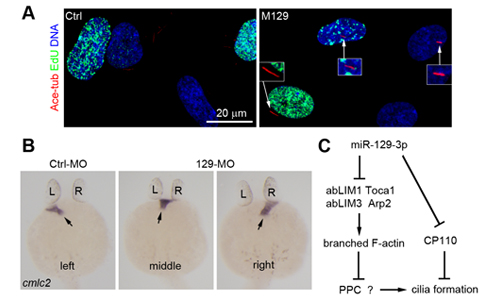Ciliogenesis requires both the removal of CP110 from the mother centriole and proper actin dynamics. How these two distinct processes are properly regulated during ciliogenesis remains unknown. Recently scientists revealed a mechanism that orchestrates both the centriole-to-basal body transition and subsequent cilia assembly through microRNA-mediated post-transcriptional regulation. The research was published online in Nature Cell.
Cilia are antenna-like projections of cells that function in sensing environmental signals, generating fluid flows, or propelling cell movement. Dr. ZHU Xueliang’s group at the Institute of Biochemistry and Cell Biology (SIBCB), Shanghai Institutes for Biological Sciences, CAS. found that miR-129-3p, a microRNA conserved in vertebrates, controlled cilia biogenesis in cultured cells by concomitantly downregulating CP110 and repressing the branched F-actin formation. Blocking miR-129-3p inhibited serum-starvation-induced ciliogenesis, whereas its overexpression potently induced ciliation in proliferating cells and also promoted cilia elongation.
They further identified four positive regulators of branched F-actin formation, Arp2, Toca1, abLIM1 and abLIM3, as the targets of miR-129-3p in ciliation-related actin dynamics. The overexpression of miR-129-3p facilitated the centrosomal accumulation of ciliogenic membrane vesicles, or preciliary pericentriolar compartment (PPC), by disruption of branched F-actin. miR-129-3p was highly expressed in mouse tissues abundant in primary cilia. Its inhibition in zebrafish embryos suppressed ciliation in the Kupffer's vesicle and pronephros and induced a curved body, pericardial oedema and radomized left-right asymmetry, which are developmental abnormalities characteristic of ciliopathies.
This work, entitled “miR-129-3p controls cilia assembly by regulating CP110 and actin dynamics”, was published online in Nature Cell Biology on June 10th, 2012.
This work was supported by grants from the Ministry of Science and Technology of China, the National Science Foundation of China, and Chinese Academy of Sciences.
AUTHOR CONTACT:
ZHU Xueliang
Institute of Biochemistry and Cell Biology, Shanghai Institutes for Biological Sciences, Chinese Academy of Sciences
Shanghai, China
Phone: 86-21-54921406; E-mail: xlzhu@sibs.ac.cn

(A) Overexpression of miR-129-3p (M129) induced ciliogenesis in cycling interphase cells. Acetylated tubulin (Ace-tub) was used as a cilia marker. EdU-positive cells are in S or G2 phase. (B)Inhibition of miR-129-3p (129-MO) in zebrafish induced defects in the left-right asymmetry. (C) Model for the functions of miR-129-3p in cilia formation. miR-129-3p controlled cilia biogenesis in cultured cells by concomitantly downregulating CP110 and repressing the branched F-actin formation. (Image by Dr. ZHU Xueliang)

